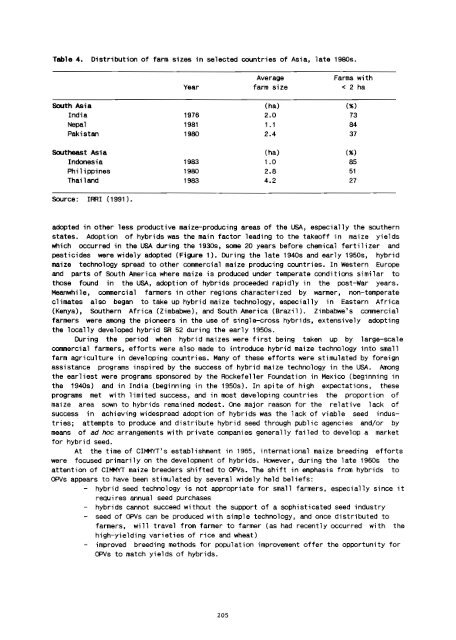Proceedings of the Fifth Asian Regional Maize Workshop - Search ...
Proceedings of the Fifth Asian Regional Maize Workshop - Search ...
Proceedings of the Fifth Asian Regional Maize Workshop - Search ...
You also want an ePaper? Increase the reach of your titles
YUMPU automatically turns print PDFs into web optimized ePapers that Google loves.
Table 4.<br />
Distribution <strong>of</strong> farm sizes in selected countries <strong>of</strong> Asia, late 198Os.<br />
Average<br />
Farms with<br />
Year farm size < 2 ha<br />
SOUth Asia (ha) (~)<br />
India 1976 2.0 73<br />
Nepal 1981 1.1 84<br />
Pakistan 1980 2.4 37<br />
SOU<strong>the</strong>ast Asia (ha) (,;)<br />
Indonesia 1983 1.0 85<br />
Philippines 1980 2.8 51<br />
Thailand 1983 4.2 27<br />
SOUrce: IARI (1991).<br />
adopted in o<strong>the</strong>r less productive maize-producing areas <strong>of</strong> <strong>the</strong> USA, especially <strong>the</strong> sou<strong>the</strong>rn<br />
states. Adoption <strong>of</strong> hybrids was <strong>the</strong> main factor leading to <strong>the</strong> take<strong>of</strong>f in maize yields<br />
which occurred in <strong>the</strong> USA during <strong>the</strong> 1930s, some 20 years before chemical fertilizer and<br />
pesticides were widely adopted (Figure 1). During <strong>the</strong> late 1940s and early 1950s, hybrid<br />
maize technology spread to o<strong>the</strong>r commercial maize producing countries. In Western Europe<br />
and parts <strong>of</strong> SOUth America where maize is produced under temperate conditions similar to<br />
those found in <strong>the</strong> USA, adoption <strong>of</strong> hybrids proceeded rapidly in <strong>the</strong> post-War years.<br />
Meanwhile, commercial farmers in o<strong>the</strong>r regions characterized by warmer, non-temperate<br />
climates also began to take up hybrid maize technology, especially in Eastern Africa<br />
(Kenya), Sou<strong>the</strong>rn Africa (Zimbabwe), and SOuth America (Brazil). Zimbabwe's commercial<br />
farmers were among <strong>the</strong> pioneers in <strong>the</strong> use <strong>of</strong> single-cross hybrids, extensively adopting<br />
<strong>the</strong> locally developed hybrid SR 52 during <strong>the</strong> early 1950s.<br />
During <strong>the</strong> period when hybrid maizes were first being taken up by large-scale<br />
commercial farmers, efforts were also made to introduce hybrid maize technology into small<br />
farm agriculture in developing countries. Many <strong>of</strong> <strong>the</strong>se efforts were stimulated by foreign<br />
assistance programs inspired by <strong>the</strong> success <strong>of</strong> hybrid maize technology in <strong>the</strong> USA. Among<br />
<strong>the</strong> earliest were programs sponsored by <strong>the</strong> Rockefeller Foundation in Mexico (beginning in<br />
<strong>the</strong> 194Os) and in India (beginning in <strong>the</strong> 1950s). In spite <strong>of</strong> high expectations, <strong>the</strong>se<br />
programs met with limited success, and in most developing countries <strong>the</strong> proportion <strong>of</strong><br />
maize area sown to hybrids remained modest. One major reason for <strong>the</strong> relative lack <strong>of</strong><br />
success in achieving widespread adoption <strong>of</strong> hybrids was <strong>the</strong> lack <strong>of</strong> viable seed industries;<br />
attempts to produce and distribute hybrid seed through public agencies and/or by<br />
means <strong>of</strong> ad hoc arrangements with private companies generally failed to develop a market<br />
for hybrid seed.<br />
At <strong>the</strong> time <strong>of</strong> CIMMYT's establishment in 1965, international maize breeding efforts<br />
were focused primarily on <strong>the</strong> development <strong>of</strong> hybrids. However, during <strong>the</strong> late 1960s <strong>the</strong><br />
attention <strong>of</strong> CIMMYT maize breeders shifted to OPVs. The shift in emphasis from hybrids to<br />
OPVs appears to have been stimulated by several widely held beliefs:<br />
- hybrid seed technology is not appropriate for small farmers, especially since it<br />
requires annual seed purchases<br />
- hybrids cannot succeed without <strong>the</strong> support <strong>of</strong> a sophisticated seed industry<br />
- seed <strong>of</strong> OPVs can be produced with simple technology, and once distributed to<br />
farmers, will travel from farmer to farmer (as had recently occurred with <strong>the</strong><br />
high-yielding varieties <strong>of</strong> rice and wheat)<br />
- improved breeding methods for population improvement <strong>of</strong>fer <strong>the</strong> opportunity for<br />
OPVs to match yields <strong>of</strong> hybrids.<br />
205

















